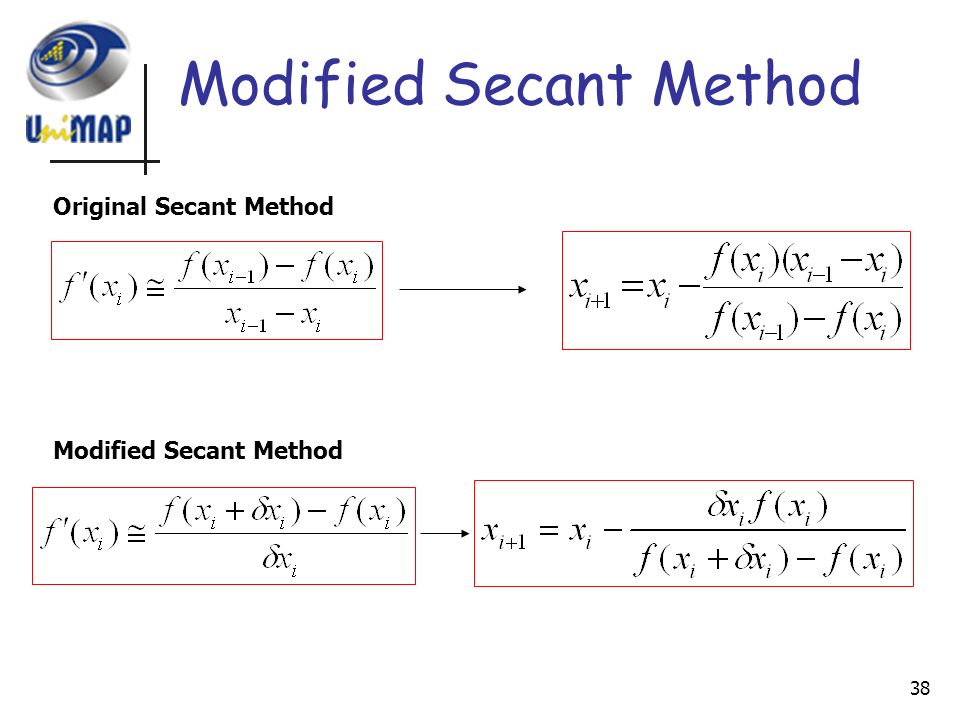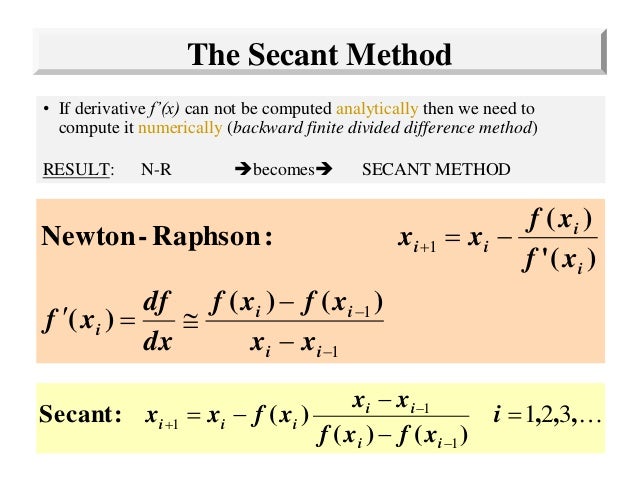Modified Secant Method Formula
Abstract: This paper presents a modification of Secant method for finding roots of equations that uses three points for iteration instead of just two. The development of the mathematical formula to be used in the iteration process is provided together with the proof of the rate of convergence which is 1.84 and is the same as the rate of convergence of Mueller's method of root finding. In fact the method is yet a discovery of a family member of Mueller's method that has linear form. Application examples are given where it is demonstrated that for equations involving ill-conditioned cases, the proposed method has better convergence characteristics compared to Newton and Secant methods.
- Secant Method Algorithm
- Newton Secant Method
- Secant Method Example
- Modified Secant Method Formula
- Secant Method Function Matlab
- Secant Method Of Root Finding
Keywords: Root finding, Secant method, Mueller’s method, Newton method, rate of numerical method.
How to cite this article:
Ababu T. Tiruneh, Tesfamariam Y. Debessai, Gabriel C. Bwembya and Stanley J. Nkambule, A modified three-point Secant method with improved rate and characteristics of convergence, International Journal of Advances in Mathematics, Volume 2019, Number 4, Pages 69-83, 2019.

Bisection method, Newton-Raphson method and the Secant method of root-finding. The software, mathematica 9.0 was used to find the root of the function, f(x)=x-cosx on a close interval 0,1 using the Bisection method, the Newton’s method and the Secant method and the result compared. It was observed that the Bisection method. Muller’s method is somewhat similar to the secant method, but instead ap-proximates the next root using a polynomial of degree 2. Muller’s method also employs the quadratic formula, and because of this complex roots of real functions can be found using Muller’s method. The formula for Muller’s method is as follows: let q = a b b c. The two methods are almost the same, from a geometric perspective. The difference is that Newton’s Method uses a line that is tangent to one point, while the Secant Method uses a line that is secant to two points. In Newton’s Method, the derivativ.
6.2
We need to determine the highest real root of:
f(x) = 2x^3 – 11.7x^2 + 17.7x – 5
a. Graphically:
root = 3.5632
b. Three fixed point method iterations where x_0 = 3
x(0)= (5 + 11.7x^2 – 2x^3)/17.7
x(1) = 3.18079
Ea = 5.68381%
x(2) = 3.33396
Ea = 4.59424
x(3) = 3.44254
Ea = 3.15407
c. Three Newton Raphson method iterations where x_0 = 3
Newton Raphson formula = x(i+1) = x(i) – f(x(i))/f'(xi)
f(x) = 2x^3 – 11.7x^2 + 17.7x – 5
f'(x) = 17.7-23.4 x+6 x^2
new x =
x(0) =3
x(1) = 5.13333
Ea = 41.5584%
x(2) = 4.26975
Ea = 20.2255%
x(3)= 3.79293
Ea = 12.5713%
d. Secant Method formula: where z = x(i-1), x = x(i), and xnew = x(i+1)
xnew = x – (f(x)(z-x))/(f(z)-f(x))
f(x) = (2x^3 – 11.7x^2 + 17.7x – 5)
x(-1) = 3
x(0) = 4
x(1) = 3.32653
Ea= 20.2454%
x(2) = 3.48127
Ea = 4.44493%
x(3) = 3.58628
Ea = 2.9281%
e. Modified Secant Method with x_0 = 3, and o = .01
x(0) = 2
x(1) = 4.8926
Ea = 59.1219%
x(2) = 4.14295
Ea = 18.0946%
x(3) = 3.74232
Ea = 10.7054%
6.5:

We need to use the Newton Raphson Method to solve the function with two separate starting points.
f(x) = -2+6x -4x^2 +.5x^3
f'(x) =6-8 x+1.5 x^2
xnew = x -(-2+6x -4x^2 +.5x^3)/(6-8 x+1.5 x^2)
a.
x0 = 4.2
x1: -4.84912
x2: -2.57392
x3:-1.13753
x4: -0.272741
Secant Method Algorithm
x5: 0.202829
b.
x0 = 4.43
x1 = -3939.13
x2 = -2625.2
x3 = -1749.25
x4 = -1165.28
x5 = -775.966
In the latter case, the function line is curving at such a fast rate the tangent is skewed.
6. 15
In this problem, we need to determine the roots of of two simultaneous nonlinear equations using fixed point iteration and the Newton – Raphson Method
a. fixed point
Real roots are x = 1.37207, y =0.239502, x = -0.186792, y= 0.528317, x = 0.528317, y = -0.585274
y = -x^2 + x +.75
y +5xy =x^2
new x = sqrt(x-y+.75)
new y = (x^2 – y)/5x
initial x and initial y = 1.2
x1 = 0.866025
y1 = -0.103923
x2 = 1.31147
y2 = 0.278142
x3 = 1.33541
y3 = 0.225426
x4 = 1.36381
y4 = 0.239704

b.
u = (x^2 + x + .75 – y)
v = (x^2 – 5xy – y)
du/dx = (1+2 x)
du/dy = (-1)
dv/dx = (2 x-5 y)
dv/dy = (-1-5 x)
Newton Raphson formula:
x new = x – (u*dvdy – v *dudy)/(dudx*dvdy – dudy*dvdx)
y new = y – (v*dudx – u*dvdx)/(dudx*dvdy – dudy*dvdx)
x new =

y new =
x0, y0 = 1.2, 1.2
x1 ,y1 = 0.386496, 0.624088
x2 ,y2 = -0.0933718, 0.435073
x3 ,y3 =-0.217136, 0.564695
6.18
In this problem, we have to use the modified secant method to solve for (dc/dt)
V(dc/dt) = W – Qc – kVsqrt(c)
Newton Secant Method
(dc/dt) =(W – Qc – kVsqrt(c))/V
(dc/dt) = f(c) = (1.-0.25*sqrt(c)-0.1*c)
f(c+o*c) = (1.-0.25*sqrt(c+o*c)-0.1*(c+o*c))
new c = c – (o*c*f(c))/(f(c+o*c)-f(c))

new c = c – (o*c*(1.-0.25*sqrt(c)-0.1*c))/((1.-0.25*sqrt(c+o*c)-0.1*(c+o*c))- (1.-0.25*sqrt(c)-0.1*c))
initial values c = 4 and o = .5
true root = 4.62408
c(1) = 4.64026
Secant Method Example
Error(t) = -0.35%
c(2) = 4.62345
Error(t) = 0.01%
c(3) = 4.62411
Error(t) = -0.0006%
Modified Secant Method Formula
6.28
We need to apply Newton-Raphson to this function with an initial guess of 16.15
The real root between 15 and 20 is 18.8948
Newton-Raphson is new x = x – f(x)/f'(x)
f'(x) = 0.0296*x^3 -0.852*x^2 +6.71*x -12.183
new x =
initial x = 16.15
x(1) = 9.0771
x(2) = -4.02094
x(3) = -0.280374
The algorithm is not approaching the desired root, rather it is moving towards the root farthest away.
6.31:
We need to use fixed point iteration to solve this equation for H.
Q = (sqrt(S)*(B*H)^(5/3))/(n*(B+2*H)^(2/3))
Q = 5, S = .0002, B = 20, n =0.03
This can be rearranged so that H = B * ((Q*n*(B+2H)^(2/3))/(sqrt(S)))^(3/5)
H(0) = 0
Secant Method Function Matlab
H(1) = 273.394
It is already moving away from the true root.
H = (sqrt(S)*(B*H)^(5/3))/(n*(B+2*H)^(2/3)) -Q + H
H(0) = 0
H(1) = -5
this is a failure as well
H = (((sqrt(S)*(B*H)^(5/3)/(Q*n) )^(3/2) -B)/(2)
H = 1/2 (-20+51.7858 (H^(5/3))^(3/2))
Secant Method Of Root Finding
I keep getting back to negative numbers which result in negative numbers.
